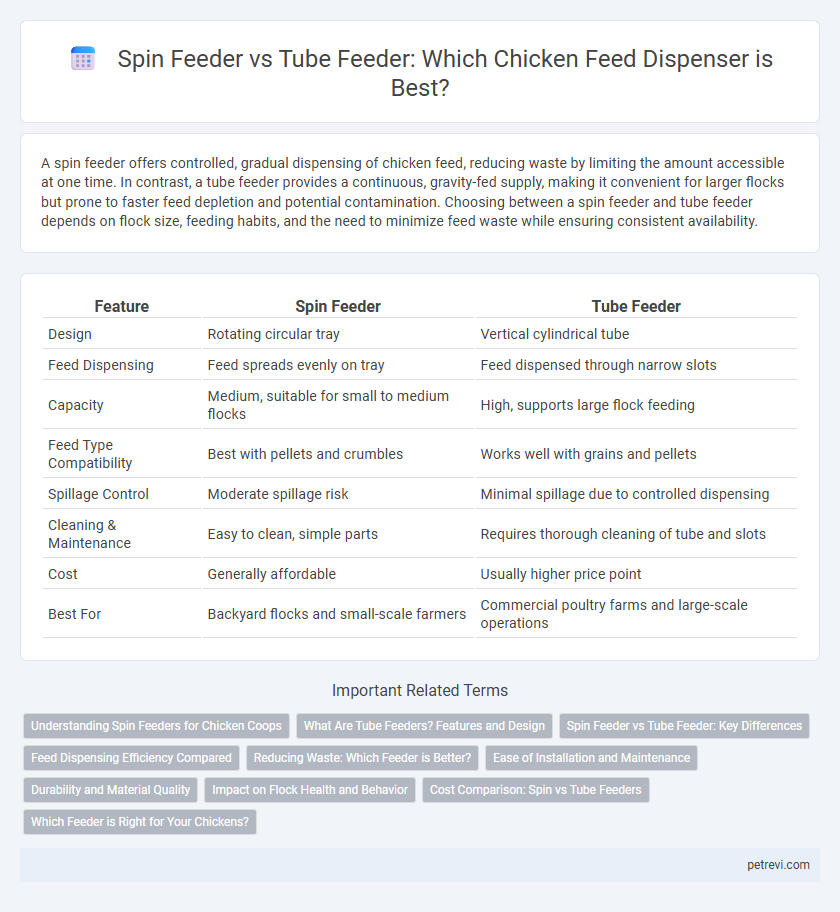A spin feeder offers controlled, gradual dispensing of chicken feed, reducing waste by limiting the amount accessible at one time. In contrast, a tube feeder provides a continuous, gravity-fed supply, making it convenient for larger flocks but prone to faster feed depletion and potential contamination. Choosing between a spin feeder and tube feeder depends on flock size, feeding habits, and the need to minimize feed waste while ensuring consistent availability.
Table of Comparison
| Feature | Spin Feeder | Tube Feeder |
|---|---|---|
| Design | Rotating circular tray | Vertical cylindrical tube |
| Feed Dispensing | Feed spreads evenly on tray | Feed dispensed through narrow slots |
| Capacity | Medium, suitable for small to medium flocks | High, supports large flock feeding |
| Feed Type Compatibility | Best with pellets and crumbles | Works well with grains and pellets |
| Spillage Control | Moderate spillage risk | Minimal spillage due to controlled dispensing |
| Cleaning & Maintenance | Easy to clean, simple parts | Requires thorough cleaning of tube and slots |
| Cost | Generally affordable | Usually higher price point |
| Best For | Backyard flocks and small-scale farmers | Commercial poultry farms and large-scale operations |
Understanding Spin Feeders for Chicken Coops
Spin feeders for chicken coops use a rotating mechanism to dispense feed gradually, reducing waste and keeping the feed cleaner compared to tube feeders. These feeders help maintain an organized feeding area by limiting access to only a few hens at a time, which prevents overcrowding and aggressive behavior during feeding. Unlike tube feeders that rely on gravity to supply feed, spin feeders offer precise control over feed distribution and can be more affordable for small to medium-sized flocks.
What Are Tube Feeders? Features and Design
Tube feeders are cylindrical containers designed to dispense chicken feed through multiple feeding ports, allowing several birds to eat simultaneously. Their vertical, space-saving design often includes a reservoir that protects feed from moisture and contamination while controlling the flow to minimize waste. Made from durable materials like plastic or metal, tube feeders offer easy refilling and hanging options, making them suitable for both small flocks and larger poultry operations.
Spin Feeder vs Tube Feeder: Key Differences
Spin feeders distribute chicken feed through a rotating mechanism that minimizes waste and provides easy access, while tube feeders rely on gravity to dispense feed from a vertical container, often leading to potential clogs. Spin feeders typically encourage active feeding behavior and reduce feed contamination, whereas tube feeders are more straightforward but may require frequent refilling and maintenance. Choosing between them depends on flock size, feed type, and desired feeding efficiency for optimal poultry nutrition management.
Feed Dispensing Efficiency Compared
Spin feeders offer more efficient feed dispensing by distributing feed evenly and minimizing waste compared to tube feeders, which rely on gravity and can cause feed clumping or uneven release. Poultry studies indicate spin feeders reduce feed wastage by up to 20%, improving feed conversion ratios and lowering feeding costs. Tube feeders, while simpler, often require regular maintenance to prevent blockages, making spin feeders a preferable choice for optimized feed management in commercial chicken production.
Reducing Waste: Which Feeder is Better?
Spin feeders reduce chicken feed waste more effectively than tube feeders by evenly distributing feed and preventing overcrowding at the feeding area. Their design minimizes spillage and keeps feed dry, reducing spoilage and ensuring maximum consumption. Tube feeders often lead to more wasted feed due to limited access points and increased likelihood of feed being knocked out.
Ease of Installation and Maintenance
Spin feeders offer quick installation with minimal tools required, making them ideal for small-scale chicken coops. Tube feeders, while slightly more complex to set up due to multiple parts, provide easy access for refilling and cleaning, enhancing maintenance efficiency. Both feeder types ensure consistent feed dispensing but differ primarily in installation time and ongoing upkeep demands.
Durability and Material Quality
Spin feeders for chicken feed dispensing typically feature durable plastic or metal construction that resists rust and weather damage, ensuring long-term usability. Tube feeders often use galvanized steel or heavy-duty plastic, known for their robustness and resistance to UV rays and corrosion, which enhances their lifespan in outdoor conditions. Material quality in both feeder types significantly affects durability, with galvanized steel tube feeders generally offering superior strength compared to most spin feeder plastics.
Impact on Flock Health and Behavior
Spin feeders promote natural foraging behavior, reducing stress and aggression among chickens, which leads to improved flock health and social dynamics. Tube feeders minimize feed wastage but can cause competition and dominance issues, potentially increasing aggressive behaviors and impacting overall well-being. Choosing the optimal feeder design supports balanced nutrition intake and positive behavioral patterns in poultry management.
Cost Comparison: Spin vs Tube Feeders
Spin feeders typically have a higher initial cost due to their mechanical design but offer efficient feed distribution that can reduce waste and save money over time. Tube feeders are more affordable upfront, with simple construction and minimal maintenance expenses, making them suitable for smaller-scale or budget-conscious poultry keepers. Evaluating long-term feeding efficiency and flock size is essential to determine which feeder type provides the best cost-effectiveness for chicken feed dispensing.
Which Feeder is Right for Your Chickens?
Spin feeders offer a larger capacity and reduce feed waste by evenly distributing food, making them ideal for larger flocks or outdoor use. Tube feeders provide controlled portions and protect feed from contamination, perfect for smaller groups or indoor coops. Selecting the right feeder depends on flock size, feeding environment, and the goal of minimizing waste versus maximizing convenience.
Spin Feeder vs Tube Feeder for Chicken Feed Dispensing Infographic

 petrevi.com
petrevi.com